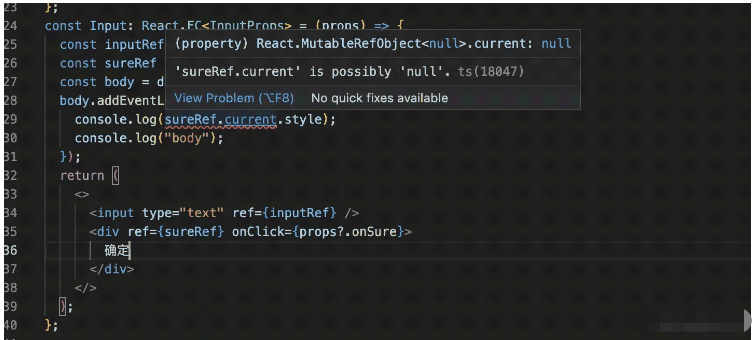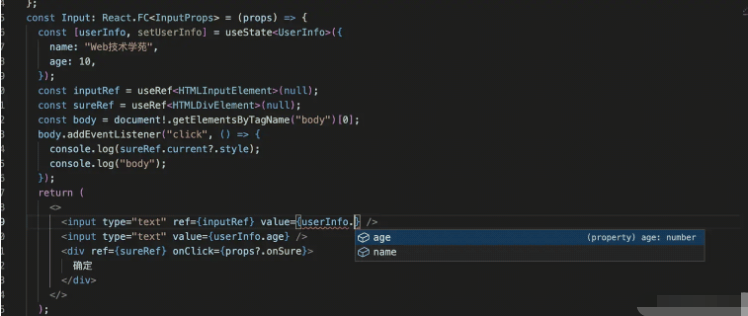您好,登錄后才能下訂單哦!
您好,登錄后才能下訂單哦!
本篇內容主要講解“react常見的ts類型怎么定義”,感興趣的朋友不妨來看看。本文介紹的方法操作簡單快捷,實用性強。下面就讓小編來帶大家學習“react常見的ts類型怎么定義”吧!
一個函數組件
import React from "react";
type Props = {
}
const Header: React.FC<Props> = (props) => {
return (<>
<div>header</div>
{props.children}
</>)
}我們注意在Header組件中有使用到props.children如果Props沒有申明類型那么此時就會報這樣的錯誤

此時我們需要加個類型就行,并且children是可選的
import React from "react";
interface Props {
children?: React.ReactNode;
}除了children,有時我想給Header組件傳入一個className,并且是可選的
import React from "react";
type Props = {
children?: React.ReactNode;
className?: string;
}
const Header: React.FC<Props> = (props) => {
const { className } = props;
return (<>
<div className={`App-header ${className}`}>header</div>
{props.children}
</>)
}在Props我們似乎對每一個可選項都有做?可選,有沒有一勞永逸的辦法
Partial<T>所有屬性都是可選
import React from "react";
type Props = {
children: React.ReactNode;
className: string;
}
const Header: React.FC<Partial<Props>> = (props) => {
const { className = '' } = props;
return (<>
<div className={`App-header ${className}`}>header</div>
{props.children}
</>)
}在以上我們給Props申明了一個children?: React.ReactNode,如果你不想這么寫,react也提供了一個屬性PropsWithChildren
interface ChildProps {}
export const SubHeader: React.FC = (
props: PropsWithChildren<{}> & Partial<ChildProps>
) => {
return <div className={`sub-header`}>{props.children}</div>;
};import React, { PropsWithChildren, useRef } from "react";
const Input: React.FC = () => {
const inputRef = useRef<HTMLInputElement>(null);
const sureRef = useRef<HTMLDivElement>(null);
return (
<>
<input type="text" ref={inputRef} />
<div ref={sureRef}>確定</div>
</>
);
};我想傳入一個方法到子組件里去
type InputProps = {
onSure: () => void;
};
const Input: React.FC<InputProps> = (props) => {
const inputRef = useRef<HTMLInputElement>(null);
const sureRef = useRef<HTMLDivElement>(null);
return (
<>
<input type="text" ref={inputRef} />
<div ref={sureRef} onClick={props?.onSure}>
確定
</div>
</>
);
};
const Index: React.FC<Partial<Props>> = (props) => {
const { className } = props;
const handleSure = () => {};
return (
<header className={`App-header ${className}`}>
<Input onSure={handleSure} />
{props.children}
</header>
);
}; const body = document!.getElementsByTagName("body")[0];
body.addEventListener("click", () => {
console.log("body");
});在sure按鈕上用ref綁定一個dom
const Input: React.FC<InputProps> = (props) => {
const inputRef = useRef<HTMLInputElement>(null);
const sureRef = useRef(null);
const body = document!.getElementsByTagName("body")[0];
body.addEventListener("click", () => {
console.log(sureRef.current?.style);
console.log("body");
});
return (
<>
<input type="text" ref={inputRef} />
<div ref={sureRef} onClick={props?.onSure}>
確定
</div>
</>
);
};
此時我們需要給sureRef申明類型,并且?訪問可選屬性
const inputRef = useRef<HTMLInputElement>(null);
const sureRef = useRef<HTMLDivElement>(null);
const body = document!.getElementsByTagName("body")[0];
body.addEventListener("click", () => {
console.log(sureRef.current?.style);
console.log("body");
});// userInterfence.ts
export type UserInfo = {
name: string;
age: number;
};
export type Menu = {
title: string;
price: number;
isChecked: boolean;
items: Array<{
name: string;
price: number;
}>;
};在另外一個組件引入
import type { UserInfo, Menu } from "./userInterfence";
const Input: React.FC<InputProps> = (props) => {
const [userInfo, setUserInfo] = useState<UserInfo>({
name: "Web技術學苑",
age: 10,
});
const inputRef = useRef<HTMLInputElement>(null);
const sureRef = useRef<HTMLDivElement>(null);
const body = document!.getElementsByTagName("body")[0];
body.addEventListener("click", () => {
console.log(sureRef.current?.style);
console.log("body");
});
return (
<>
<input type="text" ref={inputRef} value={userInfo.name} />
<input type="text" value={userInfo.age} />
<div ref={sureRef} onClick={props?.onSure}>
確定
</div>
</>
);
};
在兩個類似的組件,我們有一些公用的屬性,此時我們的類型可以借用Omit去掉一些不需要的屬性類型
import type { UserInfo, Menu } from "./userInterfence";
const MenuComp: React.FC<Omit<Menu, "items" | "isChecked">> = (props) => {
return (
<>
<p>{props.price}</p>
<p>{props.title}</p>
</>
);
};在header組件中引入
<header className={`App-header ${className}`}>
<MenuComp price={10} title={"menuA"} />
{props.children}
</header>或者你可以使用Pick來選擇指定的屬性
import type { UserInfo, Menu } from "./userInterfence";
const MenuSubComp: React.FC<Pick<Menu, "items">> = (props) => {
return (
<>
<p>{props.items[0].name}</p>
<p>{props.items[0].price}</p>
</>
);
};另一個組件中使用
const Index: React.FC<Partial<Props>> = (props) => {
const { className } = props;
const subInfo: Pick<Menu, "items"> = {
items: [
{
name: "Web技術學苑",
price: 10,
},
],
};
return (
<header className={`App-header ${className}`}>
<MenuComp price={10} title={"menuA"} />
<MenuSubComp items={subInfo.items} />
{props.children}
</header>
);
};到此,相信大家對“react常見的ts類型怎么定義”有了更深的了解,不妨來實際操作一番吧!這里是億速云網站,更多相關內容可以進入相關頻道進行查詢,關注我們,繼續學習!
免責聲明:本站發布的內容(圖片、視頻和文字)以原創、轉載和分享為主,文章觀點不代表本網站立場,如果涉及侵權請聯系站長郵箱:is@yisu.com進行舉報,并提供相關證據,一經查實,將立刻刪除涉嫌侵權內容。